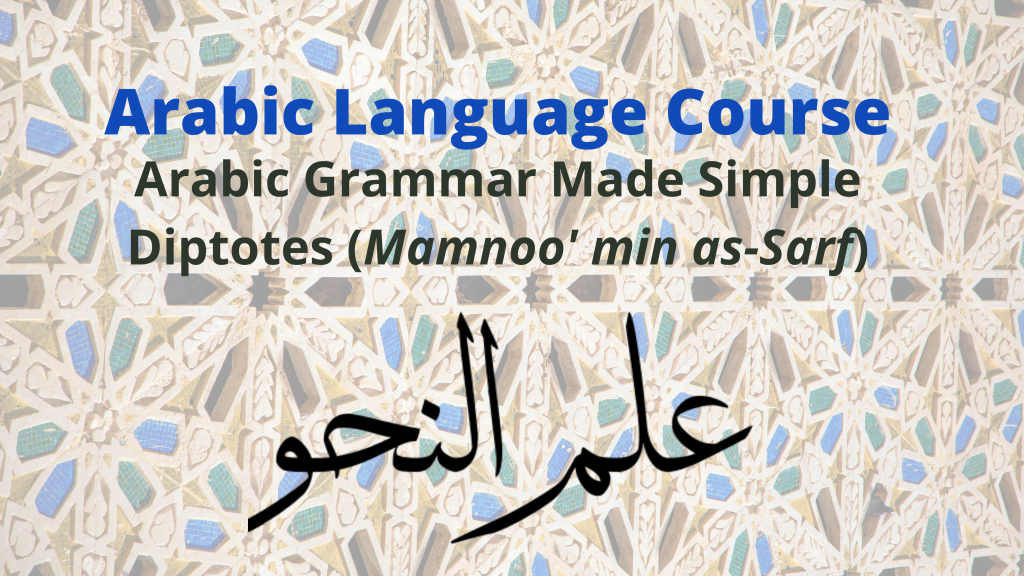Short lesson thoroughly explaining the concept of diptotes in Arabic grammar – such nouns are known as ghair munsarif or mamnoo’ min as-sarf.

What is this Tutorial About?
Arabic Reflection dealt with how nouns in the Arabic language reflect their grammatical states. Nouns were divided into sixteen categories and the methods of reflection into nine; groups of noun-types were then assigned to each method. One noun-type, however, was not thoroughly explained. This is the concept of diptotes.
About Diptotes
A diptote is a noun that reflects the nominative case with the ضمة vowel, and both accusative and genitive cases with the فتحة vowel. Moreover, such a noun does not receive تنوين التمكن (a type of nunation). In Arabic, a diptote is known as ممنوع من الصرف /mamnu’ min as-sarf/ or غير منصرف /ghair munsarif/ (change restricted).
In the examples below, note that certain words are in the genitive case yet they reflect this case with a فتحة. Note also that they do not retain nunation despite expectation of the contrary.
Translation | Example |
in many mosques | في
مساجدَ
كثيرةٍ |
the faith of Abraham | إيمان
إبراهيمَ |
Under What Circumstances Do Diptotes Become Change Restricted?
Diptotes are not always change restricted; there are cases where the last letter receives a كسرة in order to reflect the genitive state. Those cases are as follows.
· when the noun is مضاف
· when the noun is prefixed with ال
In the examples below, there are diptotes but they are not change restricted due to falling into one of the above mentioned categories.
Translation | Example |
in the predefined mosques | في
المساجدِ
المعهودةِ |
the faith of Abraham of Mecca | إيمان
إبراهيمِ
مكةَ |
Which Nouns are Diptotes
The following categories of nouns are diptotes.
1. names
or adjectives with a deviated construction
For example, the
word اُخَر
is an adjective and its construction is deviated. It’s construction is deviated
because this word is the plural for the feminine comparative word آخر. Grammar dictates that
when comparative nouns are used without ال
and they are not مضاف
that the singular masculine versions be used despite the context. Yet the
feminine plural أخر is used without ال and not as مضاف.
This usage is a deviation from the rules of grammar and so the word, coupled
with its being an adjective, is change restricted.
2. feminine names
For example, the word زينب is a name and it is feminine.
3. words feminine by means of an الف مقصورة or an الف ممدودة
For instance, the word أشياء ends in an الف ممدودة and the word كمثرى ends in an الف مقصورة. However, the word عصا, although it ends in an الف مقصورة, the الف is not for femininity, and thus عصا is not a diptote.
4. foreign names
The Hebrew names ابراهيم, إسحاق, يعقوب, إسماعيل are all diptotes.
5. nouns pluralized using a منتهى الجموع pattern
There are three منتهى
الجموع patterns in the language. These are
patterns that signify plurals that have been pluralized to the highest degree
and can be pluralized no further. Actually, these are not patterns, rather
three groups of patterns. Below is a hierarchy of these three pattern-groups;
each group contains some sample patterns, and each pattern contains some sample
words.
· a plural with an الف of plurality near the end, followed by a مكسور letter, followed by the final letter
o مَفاعِل
§ مساجد
o فَواعِل
§ فواكه
o أَفاعِل
§ أفاضل
o فَعائِل
§ كنائس
· same as above, except the final two letters after the الف of plurality have geminated
o فَواعِل
§ دوابّ
· a plural with an الف of plurality near the end, followed by a مكسور letter, followed by a long vowel ـي, followed by the final letter
o مفاعيل
§ دنانير
o فعاعيل
§ دواوين
6. hyphenated names
For example, بعلبك is a name created by hyphenating the proper nouns بعل and بك.
7. names or adjectives with an extra ـان at the end
For instance, the word سكران is an adjective meaning ‘drunk’ and its base letters are س، ك، ر. Thus the ان at the end is extra and so the word is thus a diptote.
8. names or adjectives on the pattern of a verb
The word احمد is both a name and it is on the pattern of the first-person, active imperfect verb.